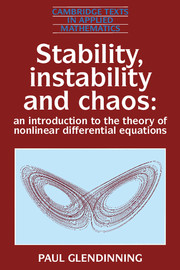Book contents
- Frontmatter
- Contents
- Preface
- Notation
- 1 INTRODUCTION
- 2 STABILITY
- 3 LINEAR DIFFERENTIAL EQUATIONS
- 4 LINEARIZATION AND HYPERBOLICITY
- 5 TWO DIMENSIONAL DYNAMICS
- 6 PERIODIC ORBITS
- 7 PERTURBATION THEORY
- 8 BIFURCATION THEORY I: STATIONARY POINTS
- 9 BIFURCATION THEORY II: PERIODIC ORBITS AND MAPS
- 10 BIFURCATIONAL MISCELLANY
- 11 CHAOS
- 12 GLOBAL BIFURCATION THEORY
- Notes and further reading
- Bibliography
- Index
8 - BIFURCATION THEORY I: STATIONARY POINTS
Published online by Cambridge University Press: 05 June 2012
- Frontmatter
- Contents
- Preface
- Notation
- 1 INTRODUCTION
- 2 STABILITY
- 3 LINEAR DIFFERENTIAL EQUATIONS
- 4 LINEARIZATION AND HYPERBOLICITY
- 5 TWO DIMENSIONAL DYNAMICS
- 6 PERIODIC ORBITS
- 7 PERTURBATION THEORY
- 8 BIFURCATION THEORY I: STATIONARY POINTS
- 9 BIFURCATION THEORY II: PERIODIC ORBITS AND MAPS
- 10 BIFURCATIONAL MISCELLANY
- 11 CHAOS
- 12 GLOBAL BIFURCATION THEORY
- Notes and further reading
- Bibliography
- Index
Summary
Bifurcation theory describes the way that topological features of a flow (properties such as the number of stationary points and periodic orbits) vary as one or more parameters are varied. There are many approaches to the problem of understanding the possible changes which occur in differential equations, ranging from a straightforward analytic description to a topological classification of all possible behaviours which may occur under an arbitrary, but small, perturbation of the system. In this chapter we aim to describe some of the simple techniques used to describe bifurcations of stationary points, adopting a heuristic approach rather than a rigorous mathematical treatment. Section 8.1 on the Centre Manifold Theorem follows the graduate textbook by Guckenheimer and Holmes (1983) quite closely. This book has become one of the standard introductions to nonlinear equations, and the next five chapters are littered with references to it. A great deal more of the detailed mathematical justification for the results described here and their implications can be found there. Our approach remains at the level of understanding systems and being able to deduce properties of examples.
The fundamental observation for stationary points of flows is that if the stationary point is hyperbolic, i.e. the eigenvalues of the linearized flow at the stationary point all have non-zero real parts, then the local behaviour of the flow is completely determined by the linearized flow (at least up to homeomorphism; see Chapter 4 and the Stable Manifold Theorem).
- Type
- Chapter
- Information
- Stability, Instability and ChaosAn Introduction to the Theory of Nonlinear Differential Equations, pp. 199 - 248Publisher: Cambridge University PressPrint publication year: 1994



